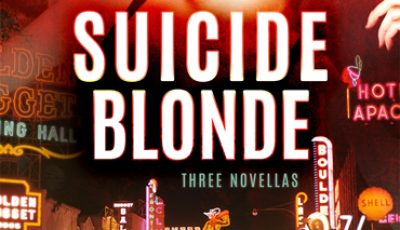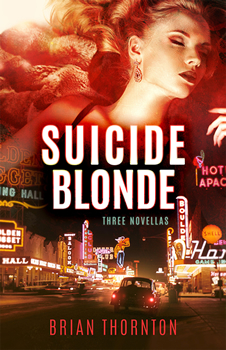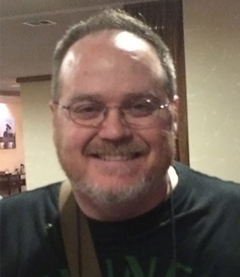

Suicide Blonde by Brian Thornton
 By Karen Hugg
By Karen Hugg
Brian Thornton loves history. “For me it’s exciting to take an actual historical event and add my own twists and takes on both the human element in every story and the human condition in general,” he says.
No wonder this author of 12 books has published such fun compendiums as The Book of Bastards: 101 Scoundrels and Scandals from the World of Politics and Power and Honest Abe: 101 Little-Known Truths About Abraham Lincoln. He’s hooked on not only the real events, but how they can be deepened and expanded through the imagination. As he says, “Evocative writing contains within it a lesson for humanity.”
Over the years, Thornton has focused mostly on the shorter forms of fiction. His work has appeared in Alfred Hitchcock’s Mystery Magazine, The Big Click, Shred of Evidence, and Seattle Noir. He’s also edited the anthologies Die Behind the Wheel and A Beast Without a Name inspired by the band Steely Dan. Now, with his new three-novella collection, SUICIDE BLONDE, he takes readers from the hot sun of Las Vegas to rainy Seattle to the deadly politics of the Mediterranean. It’s a mini world tour of historical mystery stories, each boasting their own unique culture and characters, all threaded together by intrigue and betrayal. And surprises—lots of surprises.
Thornton’s storytelling is as sharp as a knife in an Agatha Christie book. He mixes taut prose with an instinctive feel for the language of each era. It’s as if we step inside a gritty Scorsese film in the book’s title novella, “Suicide Blonde,” immersed in early 1960s Las Vegas. A mob lawyer’s got problems when his boss’s brother calls him to fix a messy situation, which only gets worse. And in “Paper Son,” the mood shifts to the more introspective cloudy culture of the Pacific Northwest in the 1800s, specifically Seattle, when it was a Deadwood-style frontier town, ruled by its own kind of mob bosses, sometimes within the Chinese immigrant population. And if that’s not impressive enough, in “Bragadin’s Skin,” Thornton brings the medieval Mediterranean to life where plotting amongst dukes and servants turns deadly against the backdrop of the Fourth Venetian-Ottoman War.
They all share a rapid but not-too-fast pace and excellent character-building. The plots inevitably expand like tight rubber bands until snapping to satisfying conclusions. One thing’s for sure: SUICIDE BLONDE will leave a smile on your face.
In this interview with The Big Thrill, Thornton delves deeper into the three novellas featured in SUICIDE BLONDE.
You display a vast and, at least to my eye, highly authentic knowledge of the cultures and eras these three stories are set in. And yet they’re all extremely different. What inspired each novella? What are your connections to Las Vegas, Seattle, and the eastern Mediterranean region? And why did you choose the historical periods that you did?
First off, thanks for the kind words. Each of these novellas actually began life as a short story. Alfred Hitchcock’s Mystery Magazine published “Suicide Blonde” in 2008. Curt Colbert tagged “Paper Son” for inclusion in Akashic Books’ anthology Seattle Noir in 2011. And I wrote the original short version of “Bragadin’s Skin” in 2013 in response to a request for a story from Nick Mamatas at The Big Click.
One of the benefits of writing short stories is that you get frequent opportunities to change things up: go wherever your interests take you. I believe that the best fiction is informed by some combination of imagination and experience. Both are nice, but you’d better have at least one if you’re going to tell a decent story.
As for connections, I was born and raised in Eastern Washington, and have lived in Seattle for the past two decades. Before I settled in Seattle I did a hitch in the Navy, went to college and grad school, then taught in Vegas for a couple of years. While I lived there I learned to love a lot of the non-Strip portions of Sin City. And the people! So many great stories. So many captivating personalities. And this was especially true of the other teachers I worked with.
So when I decided to write a mob story set in Vegas (albeit in 1962), I didn’t want it to be about cardboard cut-out, stock-character tough guys and dishy dames: all patter and glitz. I wanted to do justice to the people I’d encountered there with my writing. That’s part of why I threw in the bit about mob guys helping build what was at the time a first-class educational system in the city. They lived there. They had kids. Their kids attended these schools. So they paid their taxes and sat on school boards; two things you’ve never seen anyone associated with the multinational corporations running the casinos there now do, and likely never will.
And while I’m a committed generalist where history is concerned, I have always been fascinated by the history and culture of the eastern Mediterranean. The novella in this collection which is set there (“Bragadin’s Skin”) is a “what-might-have-happened next” story set a decade after the real-life events (in this case the Turkish siege of the Venetian-held fortress-city of Famagusta, on the island of Cyprus, in 1571) which make up the backstory of the novella itself.
Your love of the hardboiled detective genre comes through with such joy in the story “Suicide Blonde.” Do you agree and if so, what were some of your earliest influences in that genre?
Oh, absolutely. I discovered Raymond Chandler’s work when I was a teenager. From there it was a short journey to Dashiell Hammett, Ross MacDonald, James M. Cain, Leigh Brackett, and a host of others. I still regularly revisit Hammett and MacDonald. They are two of the best writing teachers you’ll ever find. Hammett for his lean prose, fast-paced plots, and sharply drawn, “real” characters. MacDonald for his ability to break down conflict between characters (especially within families) and deliver it both genuinely and empathetically. While they’re both definitely writers of “crime fiction,” for my money Hammett wrote great adventure stories and MacDonald wrote tragedies.
In “Paper Son,” the tone shifts to a cultured gentleman narrator, one who’s been around the block but isn’t born of the crude frontier. The story of his investigation into murdered Chinese laborers was a fascinating portrayal of 19th century Seattle when it was a rough logging boom town. Was it based on a true story or a tale of your own imagination? If it was true, how did you come across it?
“Paper Son” began life as research I did for an article I wrote for my university’s historical journal while earning my MA in history during the mid-’90s. The research I did about Chinese “circular migration” between the Pacific Northwest and Guangdong Province during the late 19th century helped inform and give background flavor to the story. The first-person narrator takes his name from that of a fellow grad student in my program. He went on to earn his PhD and teaches college now. The character of “Chin Gee Hee” is based on a real person—a truly impressive pioneer in the region in every sense of the word. The real Chin Gee Hee was an immigrant who found his groove as a labor wrangler and prospered by helping keep the railroad crews laying track all over the region well-supplied with Chinese labor during the 1880s-90s. He ended his career by returning to China during the early 20th century and helping to build one of their first railroads. And that bit in the story about the Chinese blasting crews nearly bringing down the side of a mountain on the heads of an Irish rail gang looking to rough them up really happened, if not exactly the way I told it.
Also, I admired the endings to these stories. They were, without giving too much away, expertly done. It’s rare and wonderful when a writer surprises with a conclusion that’s not only fitting but satisfying and delightful at the same time. Tell me about how you get to those fitting endings. Do you map out the story beforehand? Work from the last piece backward?
There’s a Dashiell Hammett short story called “The Scorched Face,” with a perfectly executed twist delivered in the story’s final sentence. I read it in my teens and to this day, several decades later, I still recall my reaction upon finishing the story and reading that twist ending.
This is a big part of why the first thing I always do when starting a writing project is make sure to work out the ending of a story. After all, who starts a journey without knowing where they’re going, or at the very least, where they hope to wind up?
History is so rich with amazing tales and events. And you bring these snapshots of time to life quite nicely in your fiction. Plus, your nonfiction books gathered together fun facts and figures of the past. When did you become interested in history? Was there any person or event early on that influenced you?
I’ve been a student of history my entire life. It began with my dad. He’s a history nut too. That was my example growing up. It’s a curse. I’m still always learning.
One of the first projects you worked on was the Seattle Noir anthology from Akashic Books. It was a great compendium of mystery stories featuring authors like Bharti Kirchner and Curt Colbert. How did that project come about? Do you think you’ll ever do another? Seattle’s often overlooked when one thinks of crime, and yet with our serial killers we have our fair share!
Akashic has done a whole series of those books, set in cities all over the globe. It’s one whale of a series, and well worth checking out. In 2010 I was Northwest Chapter president for the Mystery Writers of America, and Curt Colbert, who has since become a friend, reached out to ask whether I might know any authors looking to write noir fiction set in and around Seattle. I said, “Yes, and my name heads that list!”
And I’m always open to working on another anthology. That’s why I’ve collected and edited four of my own so far. My first one was a nonfiction project I did years and years ago. The first fiction anthology I ever collected and edited was West Coast Crime Wave (BSTSLLR, 2011). That was a lot of fun, and I learned a lot from the experience. And I recently collected and edited two volumes of crime fiction inspired by the music of jazz-rock legends Steely Dan (Die Behind the Wheel, and A Beast Without a Name, both Down and Out Books, 2019).
Tell us a little about your creative process. Do you prefer writing shorter forms? If so, why?
As far as having a process is concerned, I’ll stumble upon an idea and begin to work it out in my head (with the ending locked down first, as I mentioned earlier). I tend to process information verbally, which is a stuffy way of saying that I talk to myself when I write. I’ll work out snatches of dialogue, jotting notes as I go, and the rough idea of the story begins to take shape.
And while I love short stories, I wouldn’t say I prefer them to longer form fiction. I think it’s more accurate to say that short stories were my first successful forays into fiction. I’ve written a ton of nonfiction, published half-a-dozen books on a variety of subjects, and have no complaints about that phase of my writing career.
But the endpoint for me has always been to write fiction. I published my first nonfiction book in 2005. I wrote my first “mistake” novel in 1998-99. I published my first short story in between, in 2003. I wish I could say I’ve written dozens of short stories in the years since, but that would be a lie. In one aspect I’m like Mark Twain when it comes to short stories. He once famously said something to the effect that the shorter the piece you wanted from him, the longer it would take him to get it right. And he used short stories as a prime example of this.
I once wrote 80,000 original words in eight weeks—while also holding down a full-time day job. This was for a couple of nonfiction kids’ books I’d been contracted to write. I was up against a deadline, and out of time, so I sat down and cranked them out. I’m pretty proud of that, and the books themselves hold up. They were hardly slapped together.
On the other hand, I’ve been working on short stories off and on for 18 years. I haven’t published anything near 80,000 words worth of short stories. They just take way too long.
Related to that, what is occupying your time during this difficult 2020 year? What are you working on now, if anything? I know other writers who’ve found it enormously difficult to concentrate and get into the deep work of storytelling.
My day job (I still teach) has been a gold-plated challenge, that’s for sure. But I started 2020 on a roll, and that roll has continued. At the beginning of the year I promised myself that 2020 was the year I FINISHED several projects I’d begun and which were still hanging around in various stages of completion by the end of 2019.
As mentioned earlier, two anthologies I collected and edited were published in 2019. I had originally pitched the idea for a collection of novellas to Down and Out Books in 2017. Then Walter Becker (one half of the brain trust of Steely Dan) passed away after a long illness, and I had the idea of collecting an anthology of crime fiction inspired by the music of Steely Dan. And then one volume morphed into two, and the novella project got pushed back. After A Beast Without a Name came out last October, I set to work on expanding the short stories I had on hand into the novellas contained within SUICIDE BLONDE. And I spent the first half of 2020 wrapping up that expansion.
In addition to that I’m nearly finished with the revisions on a short story I started toward the end of 2019 and which I really need to get to the incredibly patient editor who requested them. And thirdly, I just agreed to write something for yet another anthology. The deadline on that project is New Year’s Eve, and since we’ve established that I don’t write shorts very quickly, that ought to be interesting.
Lastly, I have an historical novel set in 1844 Washington, DC, to finish and get to my agent (target date is also New Year’s). It’s been on the back burner for a while, but I’m halfway finished with final revisions, and I think I have a great shot of hitting my mark there, too.
So it’s been a lot of work, but 2020 really has shaped up to be the year that I finished up a whole lot of partially completed writing projects.
Do you have any new stories or events happening in 2021?
The two stories referenced above, and the novel my agent will be shopping. Plus, I’ve already got a few other things in the works. Writing is a funny business. It seems the more you do, the more things crop up in need of doing. And I wouldn’t have it any other way.
*****
Brian Thornton is the author of 11 books and a whole bunch of short stories. He does all of his own stunts, loves singing in the car with his son and the color blue, and lives in Seattle, where he is currently serving his third term as Northwest Chapter president for the Mystery Writers of America.
To learn more about the author and his work, please visit his website.
- Debut Spotlight: Roxana Arama - January 31, 2023
- International Thrills: Claire Douglas - August 1, 2022
- Up Close: Timothy David Mack - March 31, 2022

